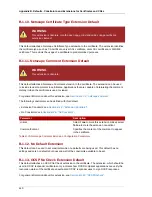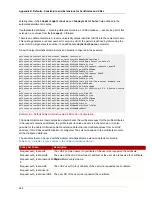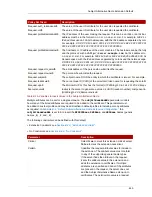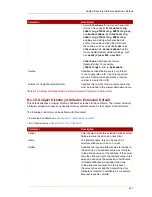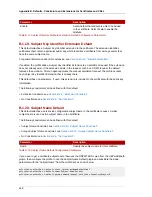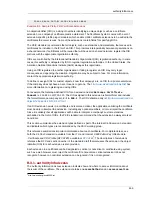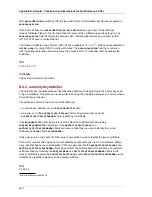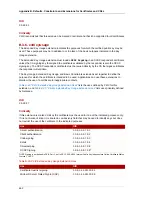
Appendix B. Defaults, Constraints, and Extensions for Certificates and CRLs
450
• If the OID of the extension is specified in both the certificate request and the default, then the
extension is validated by the constraints and applied to the certificate.
• If an OID of an extension is given in the request but is not specified in the User Supplied Extension
Default in the profile, then the user-specified extension is ignored, and the certificate is successfully
enrolled without that extension.
• If this extension is set on a profile with a corresponding OID (Extension Constraint), then any
certificate request processed through that profile
must
carry the specified extension or the request is
rejected.
A certificate
request
that contains the user-defined extensions must be submitted to the profile. The
certificate enrollment forms, however, do not have any input fields for users to add user-supplied
extensions. Submitting a certificate request without supplying the extension fails.
Example B.2, “User Supplied Extension Default for the Extended Key Usage Extension”
adds the User
Supplied Extension Default to a profile with the Extended Key Usage Constraint. The OID specified in
the
userExtOID
parameter is for the Extended Key Usage Extension.
policyset.set1.2.constraint.class_id=extendedKeyUsageExtConstraintImpl
policyset.set1.2.constraint.name=Extended Key Usage Extension
policyset.set1.2.constraint.params.exKeyUsageCritical=false
policyset.set1.2.constraint.params.exKeyUsageOIDs=1.3.6.1.5.5.7.3.2,1.3.6.1.5.5.7.3.4
policyset.set1.2.default.class_id=userExtensionDefaultImpl
policyset.set1.2.default.name=User Supplied Extension Default
policyset.set1.2.default.params.userExtOID=2.5.29.37
Example B.2. User Supplied Extension Default for the Extended Key Usage Extension
In
Example B.2, “User Supplied Extension Default for the Extended Key Usage Extension”
,
although the User Supplied Extension Default allows a user to specify the Extended Key Usage
Extension (2.5.29.37), the constraint limits the user request to only the SSL client authentication
(1.3.6.1.5.5.7.3.2) and email protection (1.3.6.1.5.5.7.3.4) uses.
Editing profiles is described in
Section 2.2.3, “Creating and Editing Certificate Profiles through the
Command Line”
.
B.1.23. User Key Default
This default attaches a user-supplied key into the certificate request. This is a required default. Keys
are part of the enrollment request.
The following constraints can be defined with this default:
• Key Constraint; see
Section B.2.4, “Key Constraint”
.
• No Constraints; see
Section B.2.6, “No Constraint”
.
B.1.24. User Signing Algorithm Default
This default implements an enrollment default profile that populates a user-supplied signing algorithm
in the certificate request. If included in the certificate profile, this allows a user to choose a signing
algorithm for the certificate, subject to the constraint set.
No inputs are provided to add signing algorithm choices to the enrollment form, but it is possible to
submit a request that contains this information.
Summary of Contents for CERTIFICATE SYSTEM 8.0 - ADMINISTRATION
Page 42: ...20 ...
Page 43: ...Part I Setting up Certificate Services ...
Page 44: ......
Page 190: ...168 ...
Page 208: ...186 ...
Page 223: ...Part II Additional Configuration to Manage CA Services ...
Page 224: ......
Page 256: ...234 ...
Page 270: ...248 ...
Page 280: ...258 ...
Page 292: ...270 ...
Page 293: ...Part III Managing the Subsystem Instances ...
Page 294: ......
Page 408: ...386 ...
Page 438: ...416 ...
Page 439: ...Part IV References ...
Page 440: ......
Page 503: ...Netscape Defined Certificate Extensions Reference 481 OID 2 16 840 1 113730 13 ...
Page 504: ...482 ...
Page 556: ...534 ...
Page 564: ...542 ...





